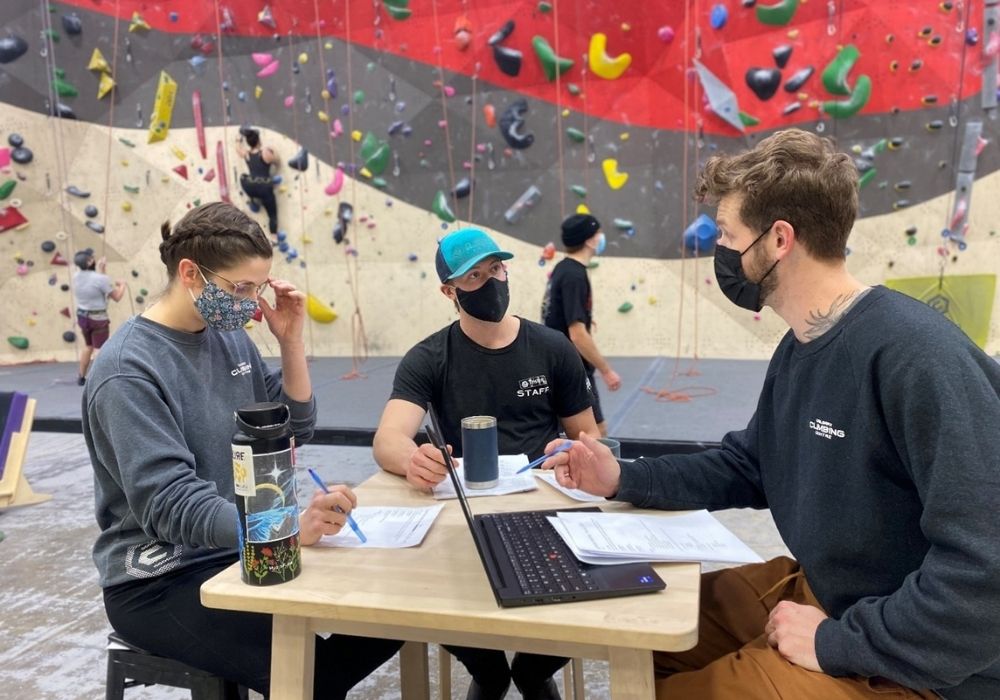Mentoring Your Staff Is Crucial and Here's Why: Part I

Mentorship has a well-established role in the history of climbing. Not surprisingly, it has a key role in the indoor climbing industry as well. Understanding mentorship, and how to utilize it as a training and performance tool, can take your team from ‘epic-ing’ with every challenge, to confidently swapping leads, managing effectively, and learning to lean on one another.
The term ‘mentor’ comes from a character in Homer’s Odyssey – a text so old that scholars don’t know exactly when it was written, or even who “Homer” was (An individual? A group of people? An ancient incarnation of the prescient Matt Groening?)
In the Odyssey, an old man named Mentor gives advice to one of the story’s young heroes on his quest – and that’s essentially what mentorship is all about – experienced folks passing on their knowledge and giving guidance to less experienced folks.
The need for mentorship in the climbing world stems from the counterculture, far-from-mainstream origins of climbing – there simply weren’t enough people climbing to support many schools or training organizations.
These schools and organizations did exist – Alpine Clubs, Scout groups, and guiding companies introduced many aspiring climbers to the technical side of climbing – but the real magic happened on real adventures; the deeper understanding and perfection of the craft came from time spent climbing with mentors.
Climbers learned from previous generations, and they learned from experienced climbers who they respected not solely because of their technical expertise, but because of their climbing ethics and style – aspects of climbing not-so-easily taught or learned in a weekend course.
The indoor climbing industry today finds itself where sport climbing was a few decades ago in terms of training and developing staff.
There are limited options for formal education or training in the indoor climbing industry, and there are few obvious, well-traveled career paths for aspiring climbing industry workers.
While staff onboarding is vital to the entire training and growth plan for employees, it is only the first part. Staff onboarding is akin to the weekend rock climbing course. Absolutely valuable, but just scratching the surface. It is an introduction to your organization’s culture and the technical aspects of the job.
The mentorships that have carried climbing knowledge through the generations have basic principles that we can appreciate, learn from, and apply to the indoor climbing industry.
They are mutually beneficial for the mentor and mentee; are relationship-based; and are outcome-driven.
In the outdoor climbing world, the mentor gains a more competent climbing partner who is less likely to kill them both on a climb; the mentor also gets the honor of contributing their own knowledge and ideas to the community.
For the mentee, they gain a wealth of knowledge about not just the techniques, but the style and ethics of their pursuit. The overall outcome on a small scale is a better rope team, and on a large scale is the pushing of standards across the sport.
In our industry, the mutual benefits of good mentorship boil down to leaders being able to develop competent and responsible staff, while the staff gain knowledge and experience that will help them grow both professionally and personally.
 The author with staff. Photo: Luna Park
The author with staff. Photo: Luna Park
In her article Why Mentors Matter: A Summary of 30 Years of Research, Laura Bidwell, Ph.D., found that mentoring in the workplace led to “significantly higher” employee engagement, and reduced turnover. This is a valuable outcome for leaders – unless you love showing new staff where the ladders are all the time.
From what I’ve seen in the indoor climbing industry at large, fostering community and personal relationships are both a priority and a source of pride. Mentorships are naturally relationship-building, as they require all the tenants of a good relationship – communication, empathy, trust, respect, and more.
While any sort of mentorship will have a relationship-building effect, Bidwell notes that “a formal mentoring program can be particularly beneficial for racial and gender minority employees, who otherwise, might not be chosen as an informal mentee.”
Essentially, adding some structure to your mentorship process can help alleviate the common bias to build relationships with those you're closest with or feel most comfortable around, often people similar to yourself.
If mentoring has been just a buzzword for you, or if you don’t have a structure for evenly applying mentorship as a training tool in your organization, you’re missing out on the full benefits of an age-old form of passing on knowledge, skills, and culture!
Start considering how you currently approach mentorship, and what you would want to pass along to the next generation.
In Part II, we’ll dig into the keys to developing a good mentorship program. Stay tuned!
Looking for a mentor of your own? Don't miss the largest indoor climbing industry event ever, the 2022 CWA Summit. Get your tickets today.
About the Author
 Brendan is a Canadian-based climber, and a Manager for the Calgary Climbing Centre. He has 10 years of management and leadership experience, and a passion for supporting the climbing lifestyle. With the Rockies as his playground, he is drawn to the incredible ice, alpine, and multipitch lines that define the local landscape.
Brendan is a Canadian-based climber, and a Manager for the Calgary Climbing Centre. He has 10 years of management and leadership experience, and a passion for supporting the climbing lifestyle. With the Rockies as his playground, he is drawn to the incredible ice, alpine, and multipitch lines that define the local landscape.
